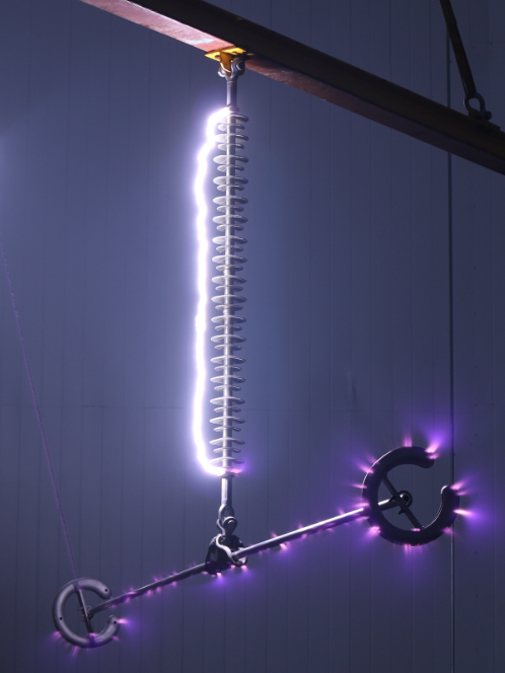
Preventing Insulator Flashover Strategies Guide
2025-08-28 15:16Avoiding insulator flashover is a critical aspect of maintaining the reliability and safety of any electrical power system, from high-voltage transmission lines to substations and industrial equipment.
Insulator flashover occurs when a disruptive discharge (an arc) travels along the surface of the insulator, bypassing its insulating properties and connecting the live conductor to the ground (tower, pole, or hardware). This can cause short circuits, power outages, and damage to equipment.
Here is a comprehensive guide on how to avoid it, broken down into key strategies.
1. Proper Insulator Selection and Design
This is the first and most crucial line of defense.
Choose the Right Creepage Distance: The creepage distance is the shortest path along the insulator's surface between the live conductor and the grounded metal. For polluted environments, longer creepage paths are required. Standards like IEC 60815 provide guidelines for selecting insulators based on the Site Pollution Severity (SPS).
Use "Anti-Fog" or "DC" Insulators: These designs have deep, alternating ribs and sheds that create a longer, more protected creepage path, making it harder for moisture and contaminants to form a continuous conductive layer.
Select the Right Material: The material's hydrophobic (water-repelling) properties are vital.
Polymer/Composite Insulators: (Made of Silicone Rubber or EPDM) are highly recommended for polluted areas. Their surface is hydrophobic, causing water to bead up rather than spread out into a continuous conductive film. They also have better pollution performance than glass or porcelain.
Porcelain/Glass insulators: These are hydrophilic (water-attracting). While still widely used, they perform worse in polluted, wet conditions unless maintained meticulously.
Increase Number of Units (for strings): For suspension or tension insulator strings in highly polluted areas, simply adding more insulator discs to the string increases the overall creepage distance and withstand voltage.
2. Regular and Effective Cleaning
Contamination is the primary cause of flashover. Keeping insulators clean is essential.
Washing: The most common method.
High-Pressure Water Jetting: Using high-pressure, low-volume water streams (often with deionized water to prevent conduction during the process) to blast away contamination.
Live-Line Washing: Specially trained crews wash energized insulators using specialized equipment and techniques to maintain a safe distance. This is crucial for critical infrastructure that cannot be de-energized.
Dry Cleaning: For light contamination, methods like using cloths or compressed air can be effective. Abrasive cleaning should be done with extreme caution to avoid damaging the insulator surface, especially silicone rubber.
3. Application of Surface Coatings
Coatings can rejuvenate or enhance an insulator's surface properties.
Silicone Grease: A traditional method. It acts as a barrier, preventing contaminants from bonding to the insulator surface. It's sacrificial—it traps the pollution and must be periodically removed and reapplied.
Room Temperature Vulcanizing (RTV) Silicone Coating: This is a more modern and permanent solution. It's a liquid silicone rubber that is brushed or sprayed onto the insulator surface. Once cured, it provides a permanent, hydrophobic layer that significantly reduces the risk of flashover. It's widely used to upgrade existing porcelain insulators in problematic areas.
4. Environmental and Site Management
Reduce the source of the contamination.
Control Pollution Sources: While not always possible, working with local industries to reduce emissions of conductive pollutants (e.g., cement dust, chemical salts, fly ash) can help.
Site Selection: When building new lines or substations, choose locations away from heavy pollution sources like coastlines, chemical plants, or quarries, if possible.
Vegetation Control: Keep trees and vegetation trimmed back from lines to prevent the deposition of organic debris and to improve air circulation, which aids drying.
5. Advanced Monitoring and Maintenance
Proactive identification of problem areas prevents failures.
Regular Visual Inspections: Look for signs of tracking, erosion, cracking, or heavy, uneven contamination.
Contamination Measurement: Periodically measure the Equivalent Salt Deposit Density (ESDD) and Non-Soluble Deposit Density (NSDD) on insulator surfaces. This quantifies the pollution level and helps plan cleaning schedules.
Use of UV Cameras: Corona discharges and surface arcing emit ultraviolet light. Specialized UV cameras can detect this "corona" activity, which is an early warning sign of impending flashover and faulty insulators.
Leakage Current Monitoring: Installing sensors to monitor the leakage current across insulators can provide real-time data on their condition. A rising trend in leakage current indicates increasing contamination and a higher risk of flashover.

What to Do During High-Risk Conditions (e.g., Fog, Light Rain)
The risk of flashover is highest when contamination is present and the insulator gets wet. During these conditions:
1. Load Reduction: System operators may reduce voltage or load on critically affected circuits to decrease the electrical stress.
2. Ensure Readiness: Maintenance crews should be on standby in known problem areas in case a flashover occurs and a circuit trips.
3. Do Not Attempt Cleaning: Cleaning during wet, energized conditions is extremely dangerous and should only be done by trained live-line crews.
By combining proper initial selection with a diligent maintenance regimen focused on contamination control, the risk of insulator flashover can be effectively minimized.
